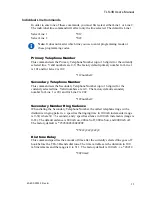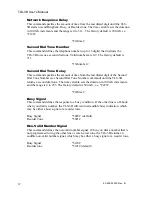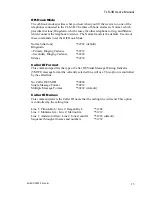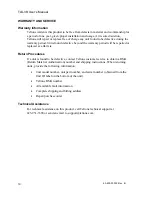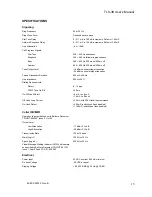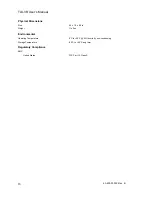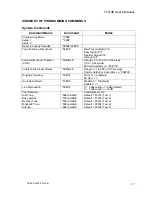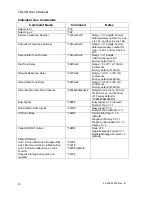
TLS-3B User’s Manual
40-400-00032, Rev. B
5
Calling Line 1
To call Line 1 (Primary):
•
Dial 101.
One long ring (2 seconds on, 4 seconds off), repeated until answer.
To call Line 1 (Secondary):
•
Dial 201.
Two short rings (programmable): 800 mS on, 400 mS off, 800 mS on, 4 seconds off
When the other telephone rings, lift the handset to answer. The two telephones are
now connected. To break the connection, hang up either telephone.
The Caller ID transmission sends the primary telephone number of the caller’s line.
Calling Party Supervision
The U.S. telephone network typically uses Calling Party Supervision, meaning that
even though the called party hangs up, he may be reconnected to the calling party
when the phone is taken off-hook again. The calling party must hang up for the called
party to be fully disconnected before initiating a new call. The telephone network will
timeout and disconnect the call within 5-20 seconds, giving the called party dial tone
when he goes off-hook again.
The TLS-3B also provides Calling Party Answer Supervision. If the called party goes
on-hook and comes off-hook again before the forced disconnect or disconnect tone is
sent, the call will be reestablished. However, if the calling party goes on-hook and
then goes back off-hook again after the forced disconnect is sent, the call will not be
reestablished.
Forced Disconnect
Cutoff On Disconnect (COD) or Forced Disconnect, as it is also called, is a feature
provided by the TLS-3B. COD is a break in loop current that is sent to the off-hook
telephone when the other party goes on-hook (hangs up). The COD pulse duration is
programmable (default is 850 ms).
The COD delay (the time from on-hook until the COD pulse is sent) is also
programmable, but only for the calling party when the called party goes on-hook.
When the calling party goes on-hook, the COD delay is always 2 seconds before the
COD is issued to the called party.
For programming information, see “System Commands” on page 9.

















